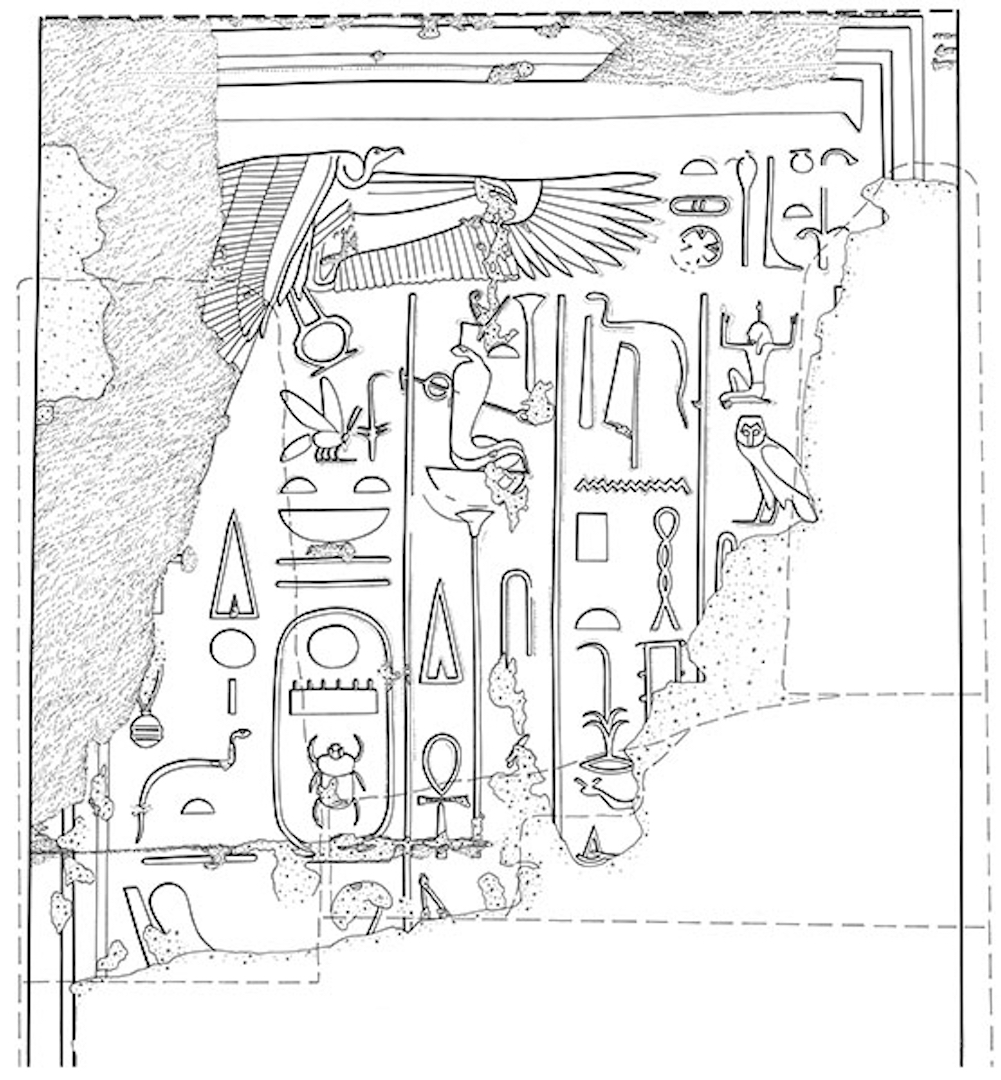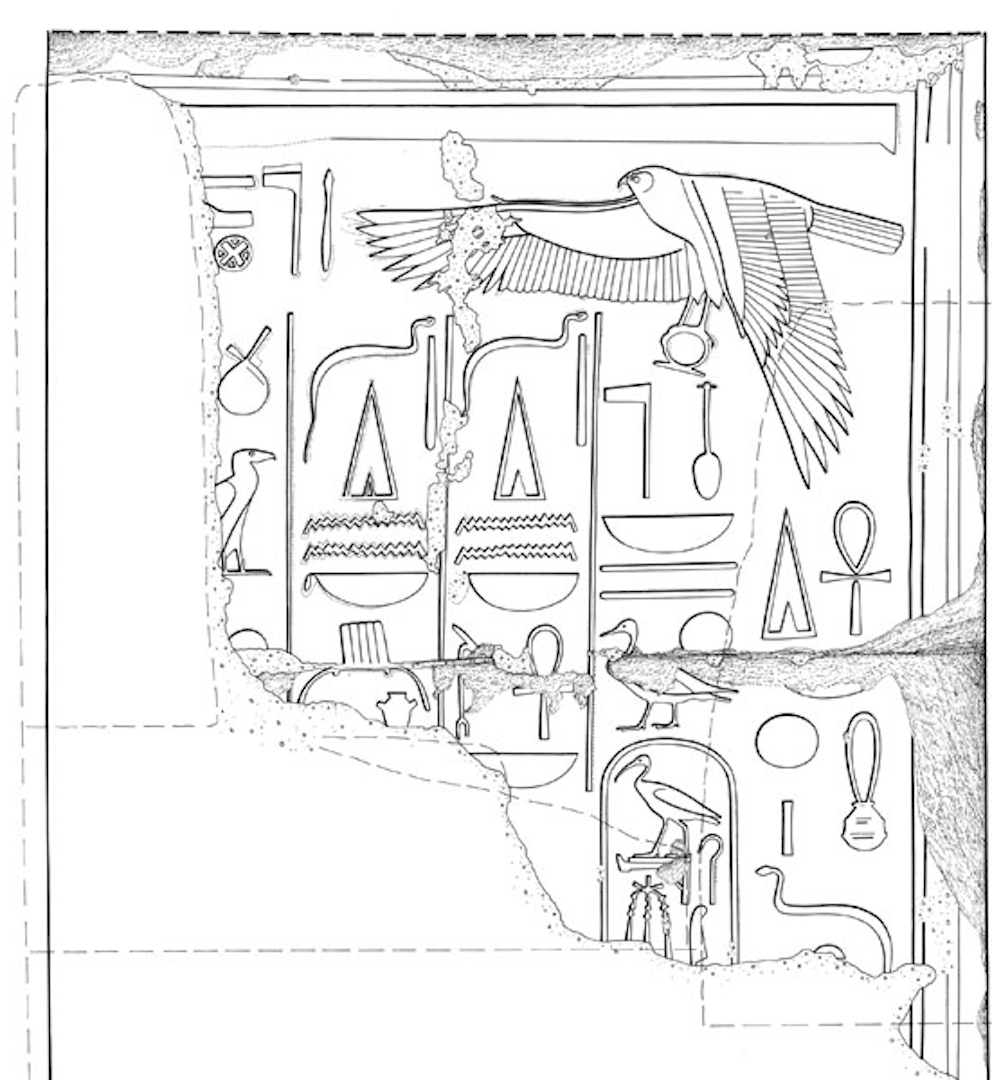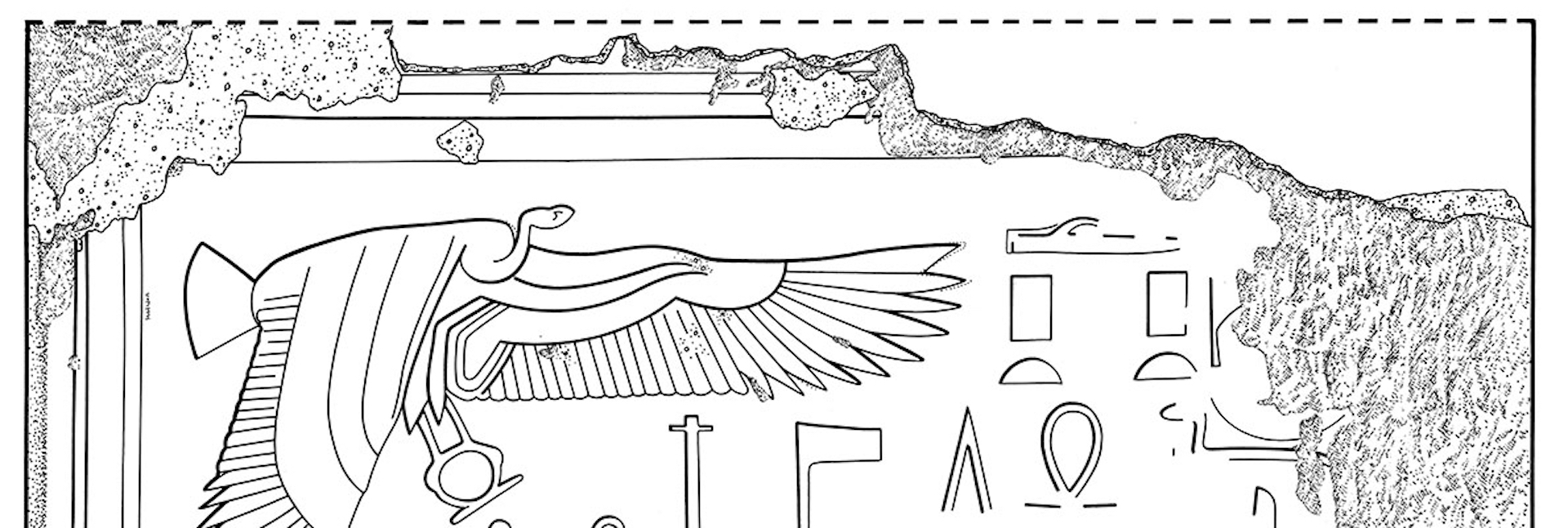Digital Epigraphy (Second Edition)
Chapter 2 – Drawing Conventions
Chapter 2, Section 4 - Architectural Obstructions
Written by W. R. Johnson, M. De Jong, S. Osgood, and K. Vértes
In the history of a monument, several stages of development can have occurred over time. When later buildings, walls or other edifices have been added so as to nearly obscure earlier inscriptions, it might be possible to record those carvings by employing any number of resourceful methods.

MHB 124, drawing by Alberts and Osgood

MHB 126, drawing by Alberts and Osgood
In the case of an inscribed stone and a wall obscuring it but sitting only a few centimeters away, an artist might use a three-dimensional “rubbing” by placing panels of aluminum foil between. The rubbing might then be “traced” over, scaled down to the required size and then transferred to enlargement paper to produce a copy of the obscured inscription.
Blocklines:
A blockline is a trace weight line (6x0/.13) used to render the interstices between block edges when the area has been damaged and the edges can be seen. If the juncture is visible the blockline is shown and is cut when the surrounding damage is cut.
%20-%20Drawing%20by%20di%20Cerbo%20and%20V%C3%A9rtes.jpg)
MHB 84 (detail) - Drawing by di Cerbo and Vértes
Work Lines and Guide Lines:
Work lines, which may extend beyond the actual carved line, are considered unintentional and are not rendered. Incised architectural guidelines are drawn with a single trace weight line (6x0/.13). An example of an incised guideline can be seen on the MHB facade.
%20and%20architectural%20guideline%20(right).jpg)
Work lines (left) and architectural guideline (right)
Damage:
In general, damage is only shown when the carved line has been interrupted. With some exceptions, damage shall not be shown in any damaged area which has never been carved.
Damage is rendered by a series of short trace weight lines which are subsequently broken (that is, cut with a scalpel) after the collation corrections have been completed. Deeper damage can be shown with more closely spaced lines and shallow damage with less spacing for a three-dimensional appearance.
%20-%20Drawing%20by%20Schenck%20and%20Osgood_1.jpg)
MHB 118 (detail) - Drawing by Schenck and Osgood
Exceptions:
The exceptions are outlined and fully explained in the document “The Chicago House Black Book” section 5.9 Damage.
In summary, damage not interrupting carved lines can be shown on facsimile drawings when the walls show damage resulting from deliberate mutilation, usually medieval chisel blows.
In very rare cases, after due examination and study, modern damage can also be shown if necessary to an historical understanding.
Damage is omitted for clarity in certain cases.
Damage is omitted when pebbles or other stone inclusions interrupt a carved line, in which case the interrupted line is left blank.
When pebbles or other stone inclusions that have interrupted a carved line have fallen way, the remaining hole may be rendered as damage.
Insect nests may be rendered as plaster or mud brick plaster.
Cement:
Usually, modern cement filling the broken edges between block courses and other holes in the walls can be outlined with a trace weight line (6x0/.13) and left blank. Cement lines are broken or cut after collation corrections are completed, along with damage.
In many cases, however, photographic documentation exists either in Chicago House archives or other collections. Portions of the inscriptions, when existing, can be copied from these images, as can damaged edges and/or holes which are now mortared over, giving more complete information.

MHB 132 (detail), drawing by Vértes
The conditions and procedure for the addition of carved inscriptions is more fully described in the “Restorations” paragraphs of this document and in the “Chicago House Black Book” section 5.14.
Plaster:
The plaster convention is rendered as widely spaced dots and small open circles placed at random using a trace weight pen (6x0/.13) in an outlined area (which has obscured the carved lines). Plaster is not broken or cut when damage is cut.
Usually, plaster is not indicated by the artist when it forms the finished surface of the wall.
Plaster Is Indicated:
...when it is Roman "filler" plaster as found in the back area of MHB.
%20-%20Drawing%20by%20De%20Jong.jpg)
MHB 53 (detail) - Drawing by De Jong
...when it is exposed in a damaged condition between block courses.
%20-%20Drawing%20by%20Schenck%20and%20Osgood_2.jpg)
MHB 118 (detail) - Drawing by Schenck and Osgood
...when accidental or intentional chipping exposes underlying plaster and interrupts the carved line (plaster damage). The artist outlines the plaster area with a trace weight line (6x0/.13) and makes the plaster dots denser on the upper edge to create the illusion of depth.
%20-%20Drawing%20by%20Osgood.jpg)
MHB 19 (detail) - Drawing by Osgood
...when a plaster "blob" obscures the carved line. The artist outlines the plaster area and makes the plaster dots denser on the bottom of the "blob" to suggest the illusion of its three-dimensional "raised" nature. Note: small dots of plaster that occur on carved lines are largely ignored and not rendered.
%20-%20Drawing%20by%20De%20Jong.jpg)
MHB 131 (detail) - Drawing by De Jong
"Mudbrick" plaster is rendered with randomly placed widely spaced dots, small open circles, larger open circles and random double lines (to represent straw).
%20-%20Drawing%20by%20Osgood.jpg)
MHB 169 (detail) - Drawing by Osgood
...when a later coating of thick plaster obscures carved lines (open plaster convention not outlined). Because large areas of scenes at MHB are sometimes covered with a plaster wash which partially obscures lines, rather than delineate the entire area of plaster-covered surface with the open plaster convention, plaster shall be indicated only where the line is obscured and left not outlined. If one side of the obscuring plaster begins with a defined edge but extends into a larger area, it can be rendered as a combination; outlined and not outlined.
%20-%20Drawing%20by%20Osgood.jpg)
MHB 109 (detail) - Drawing by Osgood
...and when a patchstone or block is missing, and the interior plaster or mortar is exposed.
%20-%20Drawing%20by%20Osgood.jpg)
MHB 21/22 (detail) - Drawing by Osgood
*All the explanatory drawings appearing in this article are drawn by W. R. Johnson and M. De Jong and the property of the Epigraphic Survey © All rights reserved.



0 comment(s)
Leave a comment(We'll keep your email address private)